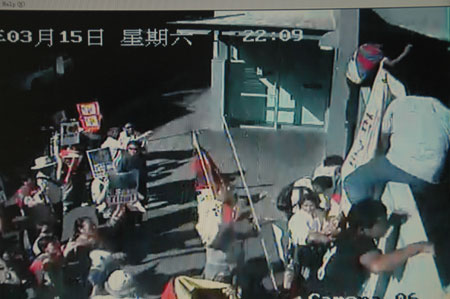|

Leading Chinese experts on Tibet on Wednesday condemned the March 14 Lhasa violence and voiced their support for the government's efforts to restore law and order.
"We strongly condemn any person who organized, premeditated, incited and participated in the riot," Professor Lhagpa Phuntshogs,China Tibetology Research Center (CTRC) general director, said at a press conference organized by the State Council's Information Office.
He said researchers on Tibet affairs were angered and distressed about the riot. "We fully support any proper measures taken by Chinese governments at all levels to maintain the social order of Tibet."
Lhagpa Phuntshogs said that under the instigation of the Dalai clique, some monks got involved in the riot. However, out of 46,000-strong monks in Tibet, only a small number participated in the arson and looting. Most monasteries had remained calm, and some monks even stood out to denounce the violence, he said.
"I myself am from Tibet. As far as I know, many religious personnel in Tibet share the view that the monks who resorted to violence had broken religious precepts and should be punished," hesaid.
Violence erupted in the Tibetan capital Lhasa on the afternoon of March 14, when rioters killed 18 civilians and a police officerand attacked schools, banks, hospitals, shops and government offices.
Damage was estimated at more than 244 million yuan (34.4 million U.S. dollars), according to official figures.
The riot was no ethnic issue, but a political one, as Tibetans and people of the Hui and Han ethnicity had all fallen victim to it, said Dramdul, director of the Institute of Religion Studies with the CTRC.
In one case, five assistants were burnt to death at a clothing store in Lhasa by a mob. Four were of the Han ethnicity, and the other Tibetan.
Dramdul, who goes by a single name, told the press conference that people with ulterior motives were using the so-called ethnic clash as an excuse to undermine ethnic harmony and the country's national unity.
In fact, he said, China advocates concord, solidarity and common progress between its different ethnic groups.
"We're pleased to see some Buddhist personnel and monastery representatives of Tibet visit the riot-hit mosques to provide comfort to Muslims. We've also seen people of different ethnic groups stand together to boycott and condemn the violence committed by a handful of rioters," he said.
"These, I believe, represent the true picture of China's ethnic relations."
The violence committed by a few lawbreakers would not undermine the harmony among different ethnic groups in Tibet; instead, it had pushed people from every ethnic group closer together, said Lian Xiangmin, director of Researching Projects Office under the CTRC.
"We also heard stories that people from different ethnic groups saved each other's lives," he said.
Lian mentioned Losang Cering, a Tibetan doctor, who suffered a broken cheekbone and cerebral concussion while saving a Han boy from rioters who attacked his ambulance.
Tanzen Lhundrup, deputy director of the Institute of Social and Economic Studies with the CTRC, told the press conference that academically, the well-being of ethnic relations could be judged from residential patterns and inter-ethnic marriages.
In Lhasa, different ethnic groups were living door-to-door, andthere were also quite a number of inter-ethnic marriages annually in the plateau city, he said.
"Overall, ethnic relations in Lhasa are very harmonious," said Tanzen who had spent more than 20 years researching the subject.
He also denounced what he termed media hype regarding population movements to Tibet, saying Tibetans remained the majority in the Chinese autonomous region.
Figures from the last two national census surveys, conducted in 1990 and 2000, respectively, showed Tibetans accounted for 95 percent and 92 percent of the region.
Only 3 percent and 6 percent of Tibet's population, respectively, was of the China majority Han ethnicity in the two surveys, Tanzen told a press conference here.
Since China's economic reform and opening-up, the entire country has seen large-scale population movements and Tibet has been no exception.
"Economic development in Tibet has attracted some non-native people to engage in commerce and construction businesses in the region," Tanzen said. "Their activities have greatly enriched and facilitated the region's market economy."
The economic output of Tibet was 34.2 billion yuan last year. With the region's population of about 2.61 million, economic output per capita exceeded 12,000 yuan in 2007. In addition, Tibet's per capita net income for farmers and nomads reached 2,788 yuan last year.
Tanzen said the economic development had benefited everyone of every ethnic group in the region.
"Everyone who has been to Tibet will find great improvements in the infrastructure and living standards of the local people, compared with three decades ago," he told reporters.
"It is undeniable that the Tibetan people have shared in the fruits of China's economic reform and opening-up and taken an active part in the country's development," he said.
The Chinese government policies in Tibet have always been aimed at raising the living standards of all people, Tanzen said.
Since the 1980s, the government has drawn up special policies and programs for Tibet based on the local situation; the rest of the country contributed funds, resources and personnel, he said.
Since 1994, the rest of China has financed 2,861 development projects in Tibet at a total cost of 9.3 billion yuan, according to official figures.
(Xinhua News Agency March 26, 2008) | 